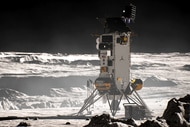X-ray signals from pulsars could soon guide autonomous spacecraft through the void
Pulsars spew out serious X-rays as they spin at breakneck speeds.

Have you ever asked a zombie for directions the you were lost? How about lost in space?
If you’re living in a post-apocalyptic nightmare like in SYFY's Day of the Dead, you’re probably better off finding your way to safety by taking a sharp turn whenever you see zombies shambling after you. You can’t even escape zombies in space. At least spacecraft don’t have to worry about being bitten and catching a virus from reanimated cosmic monsters. They could soon be using undead stars to navigate — pulsars, which are dead neutron stars that spew out serious X-rays as they spin at breakneck speeds.
Pulsars are kind of like throbbing reanimated hearts. Each superfast pulse can also double as a signal to give spacecraft an assist in navigating autonomously, which clears up congested ground navigation systems. While star trackers can tell us where something like a probe or lander is headed, until now, the precise location of the craft could only be found out through radio signals it beamed back to Earth.
Aerospace engineers Kevin Lohan and Zach Putnam of the University of Illinois want to change that. They coauthored a study recently published in IEEE Transactions on Aerospace and Electronic Systems.
“Each pulsar signal is unique in both frequency and waveform, because every pulsar rotates at a different rate, has a different alignment of their magnetic field relative to their spin axis, and a different orientation relative to the Earth,” Putnam told SYFY WIRE.
You can rely on pulsar signals because they are pretty stable and therefore predictable. However, because pulsars emit X-rays and other electromagnetic radiation, the do lose energy, so signal frequency will change as their spinning slows down. That means the shape of the wave will also evolve — or devolve, depending on how you see it. What causes the waveform to morph is thought to be caused by particles in a gas flying around randomly and disturbing electrical signals. Unfortunately, much about this “red noise” remains mysterious. Pulsars can also glitch, meaning signals suddenly change out of nowhere, but this is a rare phenomenon.
Wherever a pulsar zaps a signal, there is an exact location in space that signal reaches. This is where a new algorithm, developed by Lohan, comes in. It can think of all the possible positions a spacecraft can find itself in based on pulsar observations. After getting a sense of the signals coming from many pulsars, it then comes up with all possibilities for a craft’s position in 3D. This helped Putnam and Lohan narrow down potential spacecraft locations in certain regions.
“We typically are not concerned about how far apart the candidate locations are,” said Putnam. “It’s about how many pulsars we need to observe to reduce the number of candidate positions such that only a single one remains within the search space.”
How long it takes for a pulse to occur is an important factor in finding these locations. Short-period pulsars repeat signals extremely fast for the most accurate information on where a spacecraft could be positioned, but the problem is that they also create more signal intersections. It is easier to reduce potential locations by using longer-period pulsar signals, which don’t repeat as often, so while there is a greater chance that the signal might change in between pulses, there are also fewer intersections. Seeking out new locations means that signal intersections should have the smallest angular separation possible.
Say you have two sets of parallel lines, with one perpendicular to the other, and both lines from each set cross over both of the lines from the other. Now imagine you rotated the lines from one set while the other didn’t move. There would be a certain point where the angle between lines was narrow enough, almost parallel that instead of all lines from one set intersecting with all from the other set, only one from each set interacts with one from the other, meaning minimal angular separation. Putnam has found that a potential location needs only three intersections.
“It means a lot fewer intersections from the same two sets of parallel lines,” he said. “With enough pulsars and a finite volume of space, we’ve shown it is possible to narrow down the location of a spacecraft to a single point.”



























